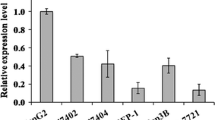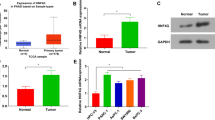Abstract
Pancreatic cancer is a serious threat to human life. Moreover, its treatment is complicated and its prognosis is very poor. Therefore, a new method for the diagnosis and treatment of pancreatic cancer is very essential. In this study, a eukaryotic expression plasmid targeting EphB4 was constructed and transfected into PANC-1 pancreatic cancer cells to investigate the inhibition of cell growth and the progression of iRNA against EphB4. This study provides the basis for the gene therapy of pancreatic cancer. The recombinant eukaryotic EphB4 expression plasmid, pSIREN-RetroQ-ZsGreen-EphB4 and a negative control plasmid, pSIREN-RetroQ-ZsGreen-N, were constructed. At 48 h after transfection, the relative messenger RNA (mRNA) and protein levels of EphB4 were measured by RT-PCR and western blot. The proliferation of the transfected cells was determined using the 3-(4,5-dimethylthiazol-2-yl)-2,5-diphenyltetrazolium bromide assay, while cell migration ability was analyzed using the scratch migration assay. At 48 h after transient transfection, EphB4 mRNA expression was significantly decreased in transfected PANC-1 cells as compared to the control group (P < 0.01). In vitro, inhibition of EphB4 expression weakened the proliferation and cell migration ability of PANC-1 cells compared to the control group. The small interfering RNA (siRNA) eukaryotic expression plasmid vector targeting EphB4 was successfully constructed and effectively transfected into PANC-1 cells. The recombinant plasmid can inhibit the expression of EphB4 mRNA and protein in PANC-1 cells, as well as cell growth and migration.




Similar content being viewed by others
References
Parkin DM, Bray F, Ferlay J, Pisani P. Global cancer statistics, 2002. CA Cancer J Clin. 2005;55(2):74–108.
Jemal A. Global cancer statistics (vol 61, pg 69, 2011). CA Cancer J Clin. 2011;61(2):134–4.
Al-Haddad M, Martin JK, Nguyen J, Pungpapong S, Raimondo M, Woodward T, et al. Vascular resection and reconstruction for pancreatic malignancy: a single center survival study. J Gastrointest Surg. 2007;11(9):1168–74.
Pasquale EB. Eph receptor signalling casts a wide net on cell behaviour. Nat Rev Mol Cell Biol. 2005;6(6):462–75.
Liu SL, Li D, Park R, Liu R, Xia ZX, Guo JC, et al. PET imaging of colorectal and breast cancer by targeting EphB4 receptor with Cu-64-labeled hAb47 and hAb131 antibodies. J Nucl Med. 2013;54(7):1094–100.
Foo SS, Turner CJ, Adams S, Compagni A, Aubyn D, Kogata N, et al. Ephrin-B2 controls cell motility and adhesion during blood-vessel-wall assembly. Cell. 2006;124(1):161–73.
Scehnet JS, Ley EJ, Krasnoperov V, Liu R, Manchanda PK, Sjoberg E, et al. The role of Ephs, Ephrins, and growth factors in Kaposi sarcoma and implications of EphrinB2 blockade. Blood. 2009;113(1):254–63.
Noren NK, Lu M, Freeman AL, Koolpe M, Pasquale EB. Interplay between EphB4 on tumor cells and vascular ephrin-B2 regulates tumor growth. Proc Natl Acad Sci U S A. 2004;101(15):5583–8.
Alam SM, Fujimoto J, Jahan I, Sato E, Tamaya T. Coexpression of EphB4 and ephrinB2 in tumour advancement of ovarian cancers. Br J Cancer. 2008;98(4):845–51.
Astin JW, Batson J, Kadir S, Charlet J, Persad RA, Gillatt D, et al. Competition amongst Eph receptors regulates contact inhibition of locomotion and invasiveness in prostate cancer cells. Nat Cell Biol. 2010;12(12):1194–U1175.
Nakada M, Niska JA, Tran NL, McDonough WS, Berens ME. EphB2/R-Ras signaling regulates glioma cell adhesion, growth, and invasion. Am J Pathol. 2005;167(2):565–76.
Testa JR, Bellacosa A. AKT plays a central role in tumorigenesis. Proc Natl Acad Sci U S A. 2001;98(20):10983–5.
Spannuth WA, Mangala LS, Stone RL, Carroll AR, Nishimura M, Shahzad MMK, et al. Converging evidence for efficacy from parallel EphB4-targeted approaches in ovarian carcinoma. Mol Cancer Ther. 2010;9(8):2377–88.
Lafleur K, Huang D, Zhou T, Caflisch A, Nevado C. Structure-based optimization of potent and selective inhibitors of the tyrosine kinase erythropoietin producing human hepatocellular carcinoma receptor B4 (EphB4). J Med Chem. 2009;52(20):6433–46.
Dopeso H, Mateo-Lozano S, Mazzolini R, Rodrigues P, Lagares-Tena L, Ceron J, et al. The receptor tyrosine kinase EPHB4 has tumor suppressor activities in intestinal tumorigenesis. Cancer Res. 2009;69(18):7430–8.
Wu Q, Suo Z, Kristensen GB, Baekelandt M, Nesland JM. The prognostic impact of EphB2/B4 expression on patients with advanced ovarian carcinoma. Gynecol Oncol. 2006;102(1):15–21.
Xia G, Kumar SR, Stein JP, Singh J, Krasnoperov V, Zhu S, et al. EphB4 receptor tyrosine kinase is expressed in bladder cancer and provides signals for cell survival. Oncogene. 2006;25(5):769–80.
Xia G, Kumar SR, Masood R, Zhu S, Reddy R, Krasnoperov V, et al. EphB4 expression and biological significance in prostate cancer. Cancer Res. 2005;65(11):4623–32.
Kumar SR, Singh J, Xia G, Krasnoperov V, Hassanieh L, Ley EJ, et al. Receptor tyrosine kinase EphB4 is a survival factor in breast cancer. Am J Pathol. 2006;169(1):279–93.
Davalos V, Dopeso H, Castano J, Wilson AJ, Vilardell F, Romero-Gimenez J, et al. EPHB4 and survival of colorectal cancer patients. Cancer Res. 2006;66(18):8943–8.
Li M, Zhao ZW. Clinical implications of EphB4 receptor expression in pancreatic cancer. Mol Biol Rep. 2013;40(2):1735–41.
Flanagan JG, Vanderhaeghen P. The ephrins and Eph receptors in neural development. Annu Rev Neurosci. 1998;21:309–45.
Pasquale EB. Eph-ephrin promiscuity is now crystal clear. Nat Neurosci. 2004;7:417–8.
Gerety SS, Anderson DJ. Cardiovascular ephrinB2 function is essential for embryonic angiogenesis. Development. 2002;129(6):1397–410.
Gerety SS, Wang HU, Chen ZF, Anderson DJ. Symmetrical mutant phenotypes of the receptor EphB4 and its specific transmembrane ligand ephrin-B2 in cardiovascular development. Mol Cell. 1999;4(3):403–14.
Kumar SR, Masood R, Spannuth WA, et al. The receptor tyrosine kinase EphB4 is overexpressed in ovarian cancer, provides survival signals and predicts poor outcome. Br J Cancer. 2007;96:1083–91.
Xia G, Kumar SR, Masood R, et al. Up-regulation of EphB4 in mesothelioma and its biological significance. Clin Cancer Res. 2005;11:4305–15.
Sinha UK, Kundra A, Scalia P, et al. Expression of EphB4 in head and neck squamous cell carcinoma. Ear Nose Throat J. 2003;82:866. 869–70, 887.
Berclaz G, Karamitopoulou E, Mazzucchelli L, et al. Activation of the receptor protein tyrosine kinase EphB4 in endometrial hyperplasia and endometrial carcinoma. Ann Oncol. 2003;14:220–6.
Steinle JJ, Meininger CJ, Forough R, et al. EphB4 receptor signaling mediates endothelial cell migration and proliferation via the phosphatilylinositol3-kinase pathway [J]. J Biol Chem. 2002;277(46):43830–5.
Kumar SR, Singh J, Xia G, et al. Receptor tyrosine kinase EphB4 is a survival factor in breast cancer[J]. Am J Pathol. 2006;169(1):279–93.
Conflicts of interest
None
Author information
Authors and Affiliations
Corresponding authors
Rights and permissions
About this article
Cite this article
Li, M., Zhao, J., Qiao, J. et al. EphB4 regulates the growth and migration of pancreatic cancer cells. Tumor Biol. 35, 6855–6859 (2014). https://doi.org/10.1007/s13277-014-1937-6
Received:
Accepted:
Published:
Issue Date:
DOI: https://doi.org/10.1007/s13277-014-1937-6




